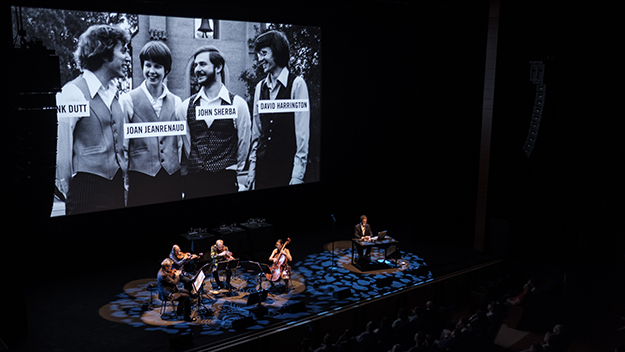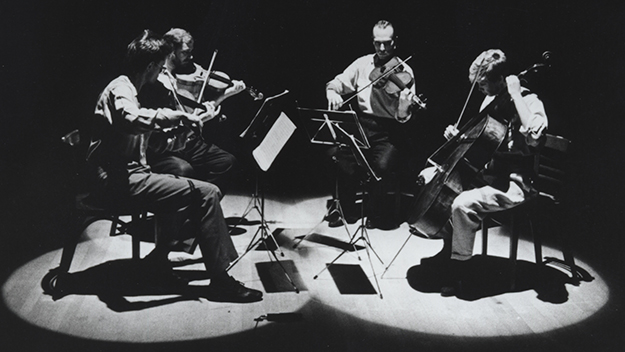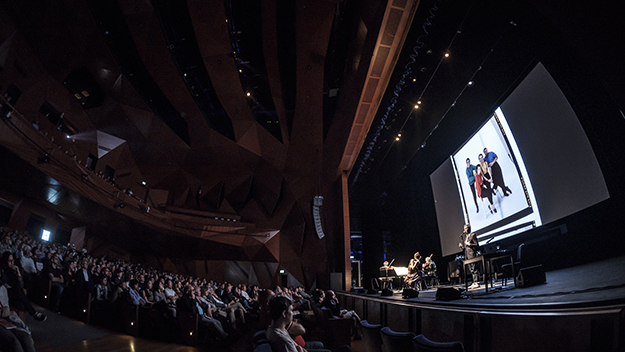Interview: Joe Bini and Sam Green

A Thousand Thoughts (Sam Green and Joe Bini, 2018). Photo by Waleed Shah.
The film camera is built to capture the moment, yet what’s captured immediately becomes the past, material for retrospective use rather than synced with this instant. While there’s plenty of premeditation to Sam Green and Joe Bini’s A Thousand Thoughts, its very design as a “live documentary” makes this foundational tension of cinema actively experienced and felt. The work is the collaboration between one artist (Green) who for many years has been mainly been working in the realm of non-traditional, performance-based filmmaking, and another (Bini) who’s mainly worked as an editor of both narrative and documentary films, most consistently with Werner Herzog. More than just a step forward for both, it’s also an ecstatic alchemical reaction forged by forces mad about the moment.
The subject of A Thousand Thoughts is ostensibly The Kronos Quartet, the formally dexterous group of San Francisco–based musicians who’ve been recording and performing for more than 40 years. During the performance of the piece, Green stands at stage right, while the Quartet is positioned on the left, and behind them, a film screen displays images and sequences prepared by Green and Bini, much of it pre-edited, some deployed on the fly by Green. While looking back at the Quartet’s history, A Thousand Thoughts presents the Quartet in the now—even archival material gets uniquely activated as it shares a proscenium with those who lived through it, remember it, and perhaps disregard it. And the audience becomes another element in the piece.
The following interview was conducted the day after the world premiere of A Thousand Thoughts at the 2018 Sundance Film Festival, when both artists were still contemplating what they’d wrought, reckoning with a piece that’s never complete without the unpredictable element of a live audience. A Thousand Thoughts comes to Town Hall in New York on April 25.
Did your artistic notions lead you to the Kronos Quartet, or did working with them and their material lead to A Thousand Thoughts being this a uniquely personal project? And how did you come to working on this together? Sam, I know you’d made a shorter piece about the band.
SG: There’s never a conscious decision that I’m going to make a film, it’s just that something sticks with me and lingers. That short film showed at the 40th anniversary of Carnegie Hall, and afterward we were all in the green room, and Janet [Cowperthwaite, Kronos Managing Director] said, “Hey, you want to do something longer?” And I was like, ugh, because music documentaries are so bad in general. So I just said, “Janet, thank you so much but I can’t.” But in the weeks and months after I was like, goddamn, there’s something there. How could I make something that gets at what got me? And I had the thought: I’ve been making these live documentaries, why don’t I do that? It solves all the problems with making a shitty documentary about [the Quartet], where there’s a story and the music is sort of an add-on. What if the music is at the heart, and the other stuff comes out of that? That’s how the idea started. And I was pleasantly surprised that they’d be up for doing this weird thing. Then Joe and I met at the Sundance Documentary Edit and Story Lab two or three years ago. I did a talk about my work and Joe did a talk about his work. I was very taken with what he said. He did a sort of kooky talk about anti-literal imagery, stuff like that. It was a rousing screed.
JB: Okay. [Laughs]
SG: I also knew that Joe was sick of editing. I have never worked in a way where there’s super-defined roles—I just like to work and to collaborate with people. Almost all the films I’ve made have been with other people. And I can edit, so it wasn’t a situation where I was asking him to be the editor. It was more, can we just collaborate together. At some point early on we were together in my studio and we were like, “Okay, for the opening let’s do this and this and this,” and I said, “Okay, I’ll go write it and come back and we’ll see how it is.” And I was like, what? I’ve never been able to write with anybody [before], it’s just never worked.
Because that’s what Joe does, or has long done.
SG: I hadn’t known that, or I hadn’t put two and two together. And I was like, “Joe, how are you such a good writer for talking?” And he was like, “I worked with Werner [Herzog] for 20 years you idiot.” [Laughs]
JB: It was very natural for me because it’s very similar to Werner’s films in a certain way. It’s all filtered through someone’s perceptions, and this someone is a character. So the character is the filmmaker, but I’m the filmmaker as well. You know it’s not Werner, it’s not Sam, it’s this character. And I immediately related to the Sam Green character, which I love. We’d met at the labs, and he gave this presentation, and I loved the conception—it really hit home with me, his main point, that [film is] theatrical. It’s necessarily theatrical, it can’t be anything else. Like you say, everything’s been reduced to shit you can watch whenever, however. So it’s not special anymore.
SG: And you have that point about how most documentaries don’t actually need to be theatrical.
JB: They’re not. Ninety-nine percent of documentaries aren’t theatrical in terms of being cinematic, but they’re also not theatrical in terms of structure. Documentary really should be an hour long, that’s an excellent format for documentary. So what’s a theatrical documentary? I got really disillusioned with that. But with Sam, that’s a compelling argument for why it should be theatrical. And I didn’t want to do some shit biopic about music—I won’t do that. And I don’t want to be the editor. So we hit it off on that, and it was a really easy collaboration. It was my first experience working with somebody who can actually edit. There’s no reason anyone can’t edit. It’s not some exclusive thing. Anybody can get the software, anybody can do it. So if we’re writing a novel together, you and I, we’re both going to type, right? We mostly communicated through cutting. It was really great. Also because the movie is not supposed to be anything, nobody knows what this format really is. I didn’t know what was going to work and what wasn’t. You have to imagine it. If you just watched it as a film, half the film is black—he’s talking.
Or the band is playing.
JB: It was hard to get the pacing until you saw it live.

The Kronos Quartet in 1987, from A Thousand Thoughts (Sam Green and Joe Bini, 2018). Courtesy of KPAA.
When did you start being able to see something live, to see if and how it might work?
JB: We rehearsed it twice. We had a week in San Francisco a couple months ago, then we had a week at Mass MoCA [Massachusetts Museum of Contemporary Art]. The one in San Francisco was just staging it and working with [the Kronos Quartet] for three days, then at the end of the week we did a performance. That one didn’t involve lighting, so it was just concentrating on the music, with [Sam] reading the narration off the page. That was first time we’d seen it.
SG: We learned a lot from that.
JB: Things worked better than I thought and other things didn’t work as well. There were times where we’d say, “It would be better if it was slightly longer, this scene,” so we recut it right there and did it. And that was pretty cool.
And could you edit down the Kronos Quartet’s performance?
JB: You would negotiate with them. [Laughs]
SG: But they would do it.
That’s a really fascinating ask. “So, you’re already doing an excerpt of this piece, but…”
SG: “…can you do it smaller?” I think they understand and accept that the music, while being the heart of the piece, is in service to the piece. So they’re not primadonnas. In fact I’ve been surprised at how un-precious they are with these pieces of music that are iconic.
JB: I was too.
In a way the Kronos Quartet are instruments, or instrumental for this larger piece—even though the piece is about them and in which they play instruments of their own. Watching them during the performance, it seemed they were reacting to things as they were happening, that they were charmed by what’s going on around them, and that became an important component for me.
SG: They’re pretty joyful people. I think they approach things with the idea of having fun and experimenting. I’ve been inspired by that, and have changed a little because of that. Because I’m pretty pent up and anxious about shit, and it’s hard to manifest that.
JB: For sure I was—and you may feel you were—much more conservative than they are. They were willing to change shit to last however long.
Knowing that you have both worked extensively in documentary, it’s tempting to look at this project as a documentary that’s been “opened up” into a performance. Or to talk about the performances and spoken word aspects as supporting or complementing the filmed aspect, or vice versa. But none of this resonates with what I witnessed in the piece, which was fully its own thing. How did you internally discuss these three realms—musical performance, spoken word, filmed footage—and how they are in dialogue with one other? What words even make sense for it?
SG: It’s in some ways unnecessary, I mean, a thing can just be a thing. I think a piece of work should be able to exist on its own terms and not need labels.
But it takes work to get there, and you’ve done all that work. And I guess I’m curious about how the work arrives at a point where we don’t need these labels.
SG: Whatever you call it, people then see it through that lens and then you’re in dialogue with all the notions and ideas and issues of that discipline. I’m very particular to call it a live documentary, because I see it as film.
Why is that important?
SG: Because what I’m doing is in dialogue with the film form. I’ve done shows where it’s a total performance, [in a] performing arts context. There’s an almost identical form in the performance world called lecture performance. But the thing is, if you call it that, you’re in the performance world and people are way more intellectual, way more theoretical. I’ve backed away from that for two reasons. One, because I want to be in the film world. I love the film world, and I feel like the film world is conservative and could use a kick in the ass. And I don’t want to be in the performing arts world because I’m unequipped, I don’t know the issues, I don’t know the history. It’s almost dangerous to go into that world without knowing the terrain.
JB: I’ve always been very intuitive and try not to theorize about things. So what I really enjoyed about this process was that I just went with it. I was trying to be really open to not over-intellectualizing it, partially because I didn’t know what the fuck was going to happen. What I’m concerned with always, and what I was concerned with here, is structure. We worked hard, the way you would with any film, to figure out the themes. Which we established fairly early on. Like any film, the question was, are we hitting those enough, is it consistent? And you couldn’t have known until you saw it completely, in that space, with them doing it.

A Thousand Thoughts (Sam Green and Joe Bini, 2018). Photo by Waleed Shah.
Last night I was sitting in the third row, where I had to look past the quartet to see the screen. And there were often silhouettes of the musicians on the screen—an additional, literally three-three-dimensional image layer to the edited film. My brain reoriented to perceiving the live performers as the traditional pictures of a documentary film, and the screen, your prerecorded imagery, became more like the soundtrack. Something like an inverse of sound and image.
SG: One of the things I really like about putting something like this together is that with a regular film you’re using images, sounds, words, and really meticulously engineering where somebody is on the screen and how [the audience] engages with it. Whereas while you’re still doing that with this, you’re also [dealing with] people being present in the room. Sometimes you are off in cinema world, and then you come back, you’re right here. It’s a really cool thing but also hard thing to engineer.
JB: What was amazing about this piece is that that’s the theme of it. So you’re intentionally aware of all that shit. It puts you on edge. But like you said a moment ago, one of the real powers of the piece is that no matter what’s going on up [on screen], they’re there [on stage]. So you’re constantly looking at them and how they are reacting, and they’re so animated and in the moment. And I never could have abstractly imagined that.
You just alluded to this, Joe, but I’m really interested in how the piece addresses and explores not just the parallel tracks of film and performance, but also of past and present, what’s been made and what’s being made, what’s historical and complete and what’s alive and incomplete, or being made complete before our eyes. Are the questions around this why straight-up documentaries can be frustrating to you?
JB: It’s one of my biggest bugaboos about documentaries. I hate documentaries. The power of the medium is present tense, and fiction is all present tense—even if you have a dream sequence or a flashback, it’s in the present tense. It’s only in documentary where it’s like, “I stood here when he walked by and he pulled the gun out, and I remember…” You’re in the present telling me a story in the past. I can’t handle it. So this necessarily had to be in the present tense.
Even though you’re telling a story about a band’s history.
SG: That was also sort of the swirl of ideas at the heart of it—it was always kind of a mess or a stew, which it still is in some ways and I think that’s ok. The idea of the present versus the desire to hold onto the past, that just sort of grew out of it and made sense.
And you’re letting me think about that. One of the more emotional moments for me was your going through the history of their instruments.
SG: I just liked that idea. Nobody knows what this violin was doing for 200 years, where it went, who had it. You know there’s a million ways to make a terrible documentary about them, and one of the ways is if it was tribute-y. So it was always really clear that we needed to make a portrait of them that evoked bigger ideas, that trafficked in something larger.
It’s the magic I always want from any kind of art, which is to have an emotional response without even knowing why I’m having an emotional response, without knowing how to quantify or justify it.
SG: But there’s also just the idea of experiencing the music in an optimal context. In a way you have to be numb not to feel something from that. It’s scientifically designed to be moving. They’re playing it, you’re feeling it, the vibrations and energy of it.
Does this piece feel closer to what you creatively want, Joe?
JB: Oh for sure. It was only last night that I realized that [this piece is] the essence of present tense. At the after party, rather than the experiences of, “Great film, man. I loved the scene where you yada yada,” it was just people trying to understand the experience they just had. And what I love is that everybody was just there. They were experiencing it, and I thought that was the colossal achievement of it.
SG: Knowing that this will never happen again.
JB: Yes, that, and also that it could fuck up. But it’s more than that, man. It’s like you were saying—I’m watching this, but oh, they’re right there [on stage], and he’s a human being. And I’m thinking, “What is he thinking?” That’s fucking present tense.
Eric Hynes is a journalist and critic, and curator of film at Museum of the Moving Image in New York.







